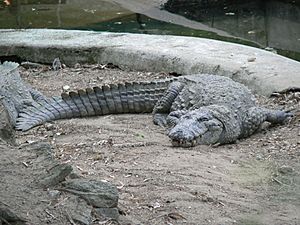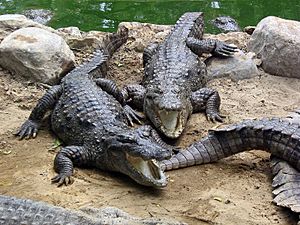Indus Crocodile facts for kids
Quick facts for kids Mugger Crocodile |
|
|---|---|
 |
|
| Conservation status | |
| Scientific classification | |
| Kingdom: | |
| Phylum: | |
| Class: | |
| Order: | |
| Family: | |
| Subfamily: | |
| Genus: | |
| Species: |
C. palustris
|
| Binomial name | |
| Crocodylus palustris Lesson, 1831
|
|
 |
|
| Distribution of Crocodylus palustris | |
The mugger crocodile (Crocodylus palustris) is also known by many other names. These include the Indian, Indus, Persian, Sindhu, or marsh crocodile. Sometimes people just call it a "mugger." You can find this crocodile across the Indian subcontinent and nearby countries. For example, in Pakistan, the Indus crocodile is the national reptile.
This crocodile is one of three types of crocodilians living in India. It's a medium-sized crocodile that prefers freshwater. You'll often find it in lakes, ponds, slow-moving rivers, swamps, and marshes. Male mugger crocodiles can grow quite large, up to 4 to 5 meters (about 13 to 16 feet) long. Females are usually smaller. The mugger crocodile has a very wide snout, which makes it look a bit like an alligator. It also has tough, enlarged scales called scutes around its neck. Adult muggers are dark grey or brown, while baby crocodiles are tan.
The mugger crocodile is a skilled hunter. Like other crocodilians, they are ambush hunters. This means they hide and wait for their prey to come close. They stay hidden in murky water, ready to attack at the right moment. Their diet mainly includes fish, other reptiles, birds, and mammals.
What's in a Name?
The name "mugger" comes from the Hindi word magar. This word itself comes from the ancient Sanskrit word makara. Makara means "crocodile" or a "mythical water monster." It's also a sign of the zodiac.
Size and Growth
The mugger crocodile is considered a medium-sized crocodile species. Males can grow up to 4 to 5 meters (13 to 16 feet) long. On average, males are about 3.2 meters (10.5 feet) long. Females are smaller, averaging about 2.45 meters (8 feet) long.
Mugger crocodiles become adults at different sizes. Females are ready to lay eggs when they are about 1.7 to 2 meters (5.5 to 6.5 feet) long. Males reach maturity when they are around 2.6 meters (8.5 feet) long.
Biology and Behavior
Mugger crocodiles can move surprisingly fast on land. They can reach speeds of about 8 miles per hour (13 km/h) over short distances when chasing prey. In the water, they are even faster. They can swim at 10 to 12 miles per hour (16 to 19 km/h) in short bursts. They usually cruise at a slower speed of about 1 to 2 miles per hour (1.6 to 3.2 km/h).
Hunting and Diet

As a large meat-eating reptile, the mugger crocodile eats many different animals. Their diet includes fish, snakes, turtles, birds, and mammals. The mammals they hunt are usually small to medium-sized. These can be animals like monkeys, squirrels, chital (a type of deer), and otters.
Any animal that comes to the water's edge to drink could become prey. Muggers will grab them and pull them into the water to drown them. Large adult muggers might sometimes hunt bigger mammals. This includes large deer like sambar, or large bovines like cattle and domestic water buffalo. However, hunting such large animals is not common.
At night, mugger crocodiles sometimes hunt on land. They hide near forest trails, waiting for prey. During these night hunts, they might even steal food from other hunters like leopards. Sometimes, they might even prey on the leopards themselves. Mugger crocodiles can be a danger to humans, but they are not as aggressive as the much larger saltwater crocodile.
Reproduction and Life Cycle
Mugger crocodiles usually reproduce during the winter months. Female muggers lay their eggs in nests. These nests are holes that they dig in the sand. The temperature around the eggs during incubation decides if the baby crocodiles will be male or female.
Images for kids
See also
 In Spanish: Cocodrilo de las marismas para niños
In Spanish: Cocodrilo de las marismas para niños





